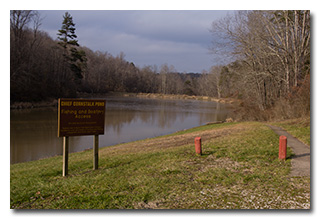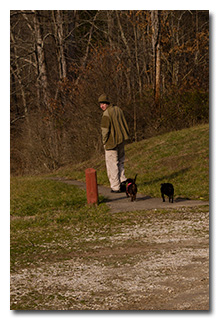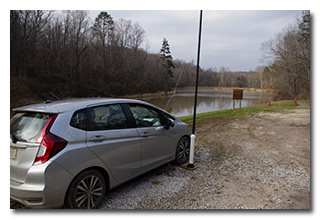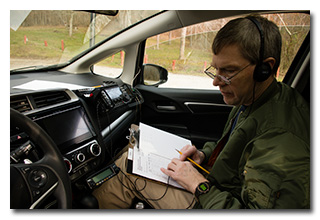
by William Eric McFadden
From the West Virginia Explorer entry:
-
The 11,772-acre Chief Cornstalk Wildlife Management Area (WMA) protects hardwood forests with gently rolling hills and moderately steep slopes in the upland between the Ohio and Kanawha rivers. Game traditionally taken in the management area includes deer, grouse, fox, mink, squirrel, turkey, muskrat, and raccoon. A five-acre lake accomodates fishing for trout, bluegill, largemouth bass, and channel catfish. The lake is stocked with trout from January to March. Fifteen primitive camping sites with vault toilets and a 200-yard shooting range have been developed.
Pictures
- The park's sign, overlooking the fishing pond
- Miles, Mindy-dog, and Theo-dog
- Eric's station overlooking the pond; photo by Miles McFadden
- Eric operating; photo by Miles McFadden
Description
 On Monday, January 11, 2021, Two members of the Southeast Ohio Radio Adventure Team
performed a successful activation of Chief Cornstalk Wildlife Management Area in West Virginia as part of the Parks on the Air (POTA; link)
program. This was the second CW POTA activation of Chief Cornstalk Wildlife Management Area.
On Monday, January 11, 2021, Two members of the Southeast Ohio Radio Adventure Team
performed a successful activation of Chief Cornstalk Wildlife Management Area in West Virginia as part of the Parks on the Air (POTA; link)
program. This was the second CW POTA activation of Chief Cornstalk Wildlife Management Area.
Eric McFadden, WD8RIF, and Miles McFadden, KD8KNC, performed the activation of Chief Cornstalk Wildlife Management Area at the park's fishing and boating access point. Eric and Miles were accompanied by the two small dogs, Mindy and Theo.
 The quartet arrived at Chief Cornstalk Wildlife Management Area at about 1930 UTC, after having to detour around a
road that had been suggested by Google Maps but turned out to be impassable by Honda Fit. After arriving at the
pull-off Eric had used at his previous activation, Eric decided to do a bit more exploration in hopes of finding a
better place to set up and operate. Not at all far beyond this pull-off, Eric found the "Chief Cornstalk Pond",
the park's fishing and boating access point, which turned out to be a far superior place to perform an activation.
After finding a place to park in the otherwise empty parking area, Eric and Miles deployed the 28½' wire
antenna on the 31' Jackite telescoping fiberglass mast and drive-on base. Deploying his KX3 on the mobile-mount on
the car's dashboard, Eric was on the air at 1957 UTC.
The quartet arrived at Chief Cornstalk Wildlife Management Area at about 1930 UTC, after having to detour around a
road that had been suggested by Google Maps but turned out to be impassable by Honda Fit. After arriving at the
pull-off Eric had used at his previous activation, Eric decided to do a bit more exploration in hopes of finding a
better place to set up and operate. Not at all far beyond this pull-off, Eric found the "Chief Cornstalk Pond",
the park's fishing and boating access point, which turned out to be a far superior place to perform an activation.
After finding a place to park in the otherwise empty parking area, Eric and Miles deployed the 28½' wire
antenna on the 31' Jackite telescoping fiberglass mast and drive-on base. Deploying his KX3 on the mobile-mount on
the car's dashboard, Eric was on the air at 1957 UTC.
Having had no cell-signal at all at his previous activation of this park, Eric was pleased to find that this time he had just enough cell-signal to text his friends K8RAT and K4SWL for spotting-support.
Eric began operations on 80m and his first QSO came almost immediately at 1958 UTC, with the aforementioned K4SWL in North Carolina. QSOs came quickly, with Eric's seventh QSO coming at 2004 UTC with N4EX in North Carolina. This run included a QSO with the aforementioned K8RAT in Ohio.
 Switching to 40m, Eric's first QSO came at 2007 UTC with KG8P in Michigan. QSOs came very quickly,
with Eric's thirty-second QSO on 40m coming at 2032 UTC with VA3SN in Ontario. This run included a
second QSO with K4SWL.
Switching to 40m, Eric's first QSO came at 2007 UTC with KG8P in Michigan. QSOs came very quickly,
with Eric's thirty-second QSO on 40m coming at 2032 UTC with VA3SN in Ontario. This run included a
second QSO with K4SWL.
In all, Eric made thirty-nine QSOs in just about thirty-five minutes. All of Eric's QSOs were CW and were made at the 5-watt level.
Miles did not operate but helped with navigation, set-up and tear-down, photography, and dog-wrangling.
When it came time to leave the park, Google Maps again directed Eric onto a road impassable by Honda Fit. This road, "Middle 9 Mile Road", was later identified as the other end of the same impassable road that Google Maps had directed them onto earlier.
(return)
